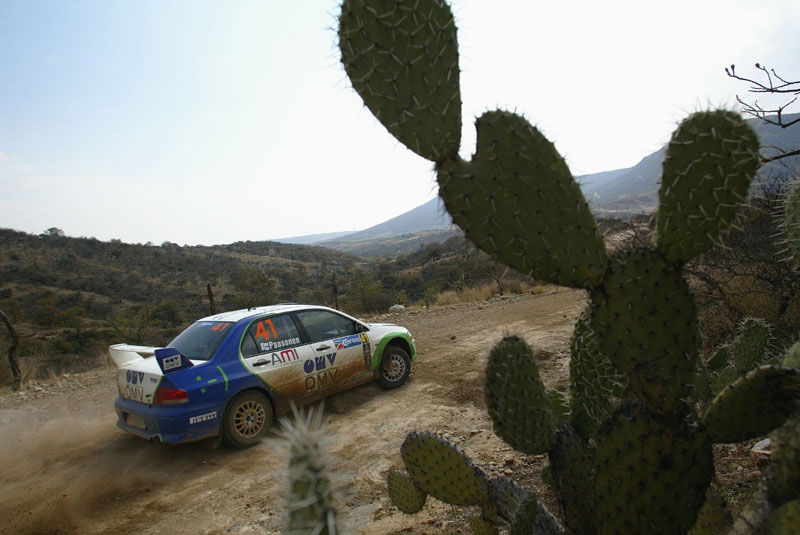Q&A: Michel Nandan (chief engineer - Peugeot).
Even more than in the case of road cars, hydraulics play a fundamental role in the performance of a World Rally Car. Peugeot Sport's chief engineer, Michel Nandan explains...
Q:
Michel, in what ways are hydraulics used on the 307 WRC?
Michel Nandan:

Even more than in the case of road cars, hydraulics play a fundamental role in the performance of a World Rally Car. Peugeot Sport's chief engineer, Michel Nandan explains...
Q:
Michel, in what ways are hydraulics used on the 307 WRC?
Michel Nandan:
Hydraulics serve mainly to control a package of mechanical functions with a view to making them more driver friendly. Whereas the emphasis in the case of a road car is essentially on driver comfort, the priority in competition, with the 307 WRC, is to enable save the driver time in the various functions he has to perform.
Q:
How does this apply in rallying?
MN:
As on a road car, the brake system is obviously independent, but we also use hydraulics inside the shock absorbers we produce ourselves. As was previously the case with the 206 WRC, we use two completely independent hydraulic circuits, one exclusively for the power steering and the other for the other hydraulically operated features, i.e. the differentials, the gearbox and the antiroll bars. Using distinct circuits means that a failure does not affect all the car's hydraulic functions. Also, should there be a problem with one of the systems, default modes mean that retirement is not automatic, although they don't prevent lots of time being lost if an incident does occur...
Q:
Why is it so costly in time terms when a WRC car has to run without power steering?
MN:
Because all the steering kinetics are designed to function with hydraulic power-assistance. This enables us to use very advanced steering geometry for optimal results. If the system fails, however, the driver has to make a considerable physical effort which detracts from efficiency and precision.
Q:
Brakes are essentially operated by the driver, by pressing on the pedal. How are the other systems controlled?
MN:
The brake system is based on a classic independent circuit. For the other hydraulically operated functions, the pressure is generated by a mechanical pump. An electrically-driven valve permits the hydraulic fluid to pass towards some actuators, generating more or less travel of the fluid within the system to achieve the required value. Electronics are primordial here. In rallying, they allow each setting to be modified according to the running conditions.
Q:
Carry on...
MN:
A number of pre-determined functional modes are programmed into the car's ECU. This means, for example, that during a stage the driver can call on a selection of differential mappings each of which controls the hydraulic pressure applied to the organ concerned. According to stage conditions, whether you're competing on asphalt, rough gravel or sheet ice, the servo power must keep the amount of effort that the driver has to apply to a minimum while at the same time leaving sufficient sensitivity for him to be able to 'feel' the car's response. It's a case of finding the right balance between acceleration, the angle of the steering wheel angle, speed, etc. A whole host of parameters are monitored by probes and transit via the ECU which in turn adjusts the electrical impulse that controls the appropriate hydraulic aperture.
Q:
Are some rallies more demanding than others for the system?
MN:
When hydraulic pressure is generated, the fluid heats up. The rougher the terrain, the twistier it is, or the higher the ambient temperature, the more that is demanded to the steering. This is notably the case in Cyprus or Greece. That said, the fluids supplied by our lubricant partner, Total, do not in general pose a problem. Except for some small, specific enhancements, their specification is very similar to the fluids used on road cars, the basic quality of which is today excellent.
Q:
Was it not excessively high pressure that led to the troubles you have had on recent rallies?
MN:
The regulations limit hydraulic pressure to 150 bar, which is less than that employed on many road cars. The steering problems we have had concern leaks in a number of places, but it's not a case of a holed pipe that will simply fail further down the line once the initial leak has been cured. We have a thorough understanding of this system which is directly derived from that used on the 206 WRC, and we didn't have a single problem in a full year of testing. Initially, we believed that the problem was due to a weakness of certain parts. But that isn't the case as it turns out. In fact, competing in rallies has revealed that the mechanicals of the 307 WRC subject to parasite vibrations, affect the reliability of certain components. For New Zealand, we have done all in our power to eradicate the problem.
